When entering the aquarium space, you may be stumped trying to figure out which aquarium plants to house a with your aquatic pets. Some aquarists opt for artificial plants over live plants because they believe caring for them will be too difficult. Don’t be deterred by that. Live plants not only look good in aquariums but also benefit the aquarium’s ecosystem. They act as a filtration system, absorb carbon monoxide released by your little friends, and offer hiding places for your fish.

To simplify things, I’ll list the top aquarium plants for beginners. These plants are easy to care for and bring color and vibrancy to your aquarium.
Top Easy Aquarium Plants For Beginners
As a beginner, it’s important to choose easy-to-care for plants; it’s best not to select a plant that requires everyday care. Getting the right beginner aquarium plant from the start will kick-start your learning process and your journey into the aquatic world.
The best beginner aquarium plants are low-maintenance and offer many benefits. Aquarium plants benefit the aquarium ecosystem by acting as a filtration system, controlling algae growth, and improving water quality by filtering out carbon monoxide while creating oxygen.
However, many beginners fail to keep their live aquarium plants from turning brown because they choose plants that require more care than they can provide. Choosing easy aquarium plants you can adequately care for is better than opting for something flamboyant that’ll wither due to lack of care.
The plants listed in this guide are some of my favorite low-maintenance aquarium plants. They look good while being beneficial to your aquarium, and you don’t have to stress over their daily care.
Cryptocoryne wendtii

Cryptocoryne wendtii is one of my favorite low-maintenance aquatic plants. It’s a slow-growing aquarium plant that doesn’t require fertilizer. With proper lighting, it will thrive in any substrate with varying conditions.
Cryptocoryne gets most of its nutrients through its roots, so if the substrate in your aquarium isn’t nutrient-dense, regularly adding root tabs for aquarium plants will promote optimum plant health.
Cryptocoryne wendtii care is relatively straightforward; provide them with sufficient light and root tabs for nutrients, and this plant will thrive no matter the condition. It comes in varieties ranging from brown to tropica, green, and red; consider adding extra iron supplements to your aquarium water to enhance the redness of the plant.
When newly added to a tank, crypt leaves may fall backward, but don’t worry! Leave it planted in the substrate and allow it to acclimatize to the water chemistry, and it’ll quickly come back to life and grow new leaves.
Amazon Sword

The Amazon sword is a classic in the aquatic plant world. It’s known for its ability to grow large, beautiful leaves that improve the look of your aquarium.
Amazon sword plant care is easy; It’s a low-maintenance aquarium greenery that simply requires lots of root tabs for plants due to their need for vital nutrients. Lighting and substrate don’t really play a huge role in how the plant grows, so you don’t need to concern yourself with that.
When you first buy this plant, its leaves may be more round because they’re often grown out of water. But once it’s placed in water, it absorbs nutrients and releases its narrow leaves, which beautifully cover the aquarium. It’s one of the easiest large aquarium plants to care for, but if the leaves seem to be yellowing, ensure that more root tabs are provided.
Want healthier fish? Check out why floating freshwater plants are a great addition to your tank.
Marimo Moss Ball

Known by aquarists as the easiest aquarium “plant” but is neither a plant nor moss. The Marimo moss ball is a naturally occurring ball of Cladophora algae.
It is a beginner-friendly aquarium plant as it requires little to no care; the marimo moss ball care requirement is to lightly roll it in your hands during every water change to maintain its round shape and ensure every part of the algae receives adequate light.
This unique aquarium plant is so inexpensive that lots of people often buy it in bulk to fill their betta tanks. They can also be unrolled and wrapped around driftwood to make a tiny tree.
Aponogeton Crispus

The Aponogeton crispus is a low-light aquarium plant that sprouts from a bulb, creating wavy edges and long leaves that flow with the water current in the aquarium. Most pet stores sell this plant as a betta bulb because it is easy to care for.
Get the bulb and place it on top of your substrate, and you’ll be surprised how it blooms. However, it goes through a dormancy period where the larger leaves die for a couple of months; don’t move the plant, and after a few months, new growth will emerge. Aponogeton crispus care is quite easy; it requires a nutrient-dense substrate and sufficient light.
The plant grows relatively tall and produces flowers, making it a beautiful addition to your aquarium. It is one of the few flowering aquarium plants available in stores. The aquarium bulbs can be obtained from any store selling live aquarium plants.
Bacopa Carolinians

Bacopa caroliniana is a beginner-friendly option. It’s a stem plant native to the southern United States. It features a vertical stem with small round leaves. It doesn’t require a lot of maintenance but enjoys liquid fertilizers.
This beginner stem plant can grow in low light but reacts adversely to iron dosing and high light, causing the leaves to turn red.
Common amongst most aquarium plants, Bacopa is often grown out of water, so once it’s placed in the tank, the plant starts to produce new leaves while the older leaves that were grown out of water wither and fall off; the plant will look bare at the bottom, so snip off the top and replant them in the substrate to get a fuller plant.
That is also the process of how to propagate Bacopa; as the plant continues to grow tall, keep snipping off the tops and replanting in a new location.
Aquarium plant propagation is an easy way to get multiples of the same plant without spending a lot of money. It is economical and fun to create more plants from a single purchase.
It is a low-light stem plant, so the Bacopa caroliniana care routine is quite straightforward: keep it in a low-light environment but in a nutrient-rich substrate.
Java Fern
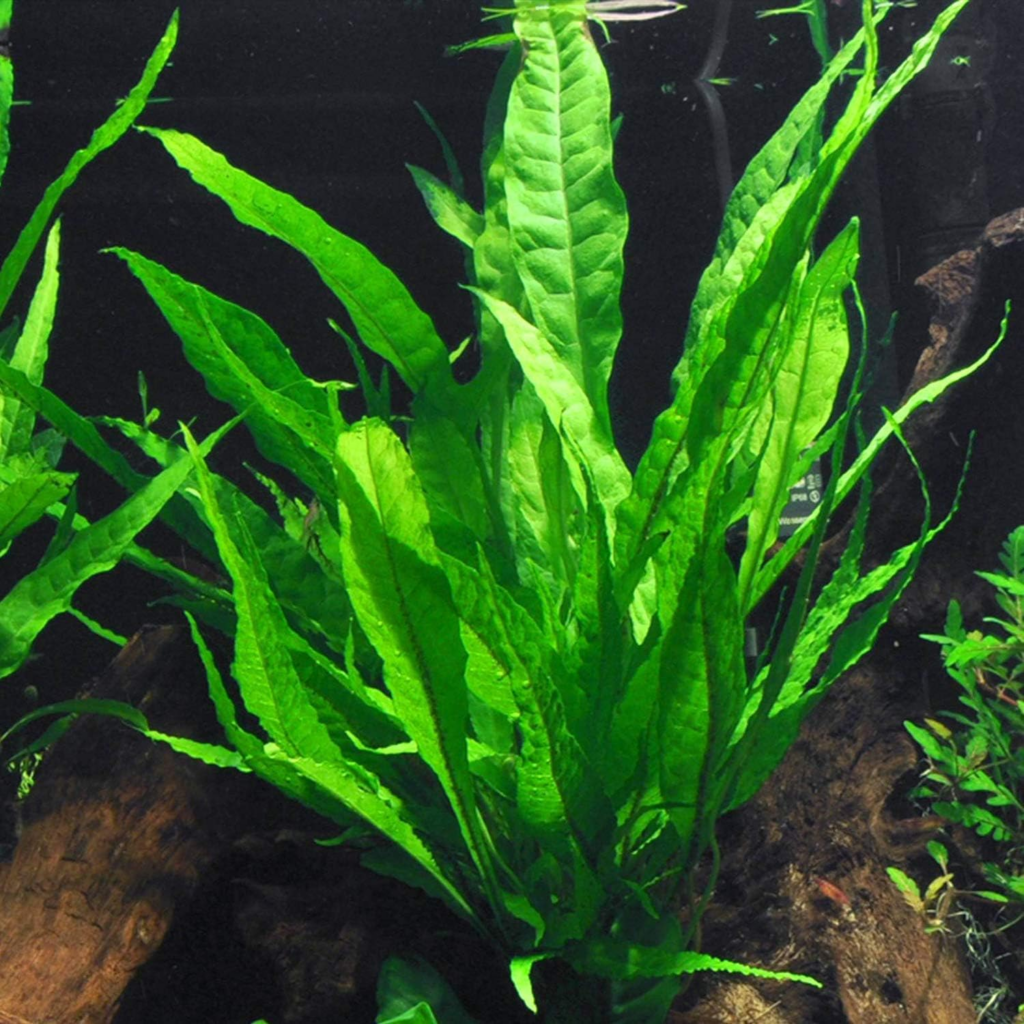
The Java Fern is another popular aquarium plant that gets its name from the Indonesian island of Java. It is easy to care for and comes in different varieties such as needle leaf, narrow leaf, and trident leaf; but the most popular among aquarists is the type with long pointed leaves and ridged veins.
Java ferns grow in most lighting conditions but prefer a subdued fluorescent light; the plant may turn brown if the light is too intense. This rhizome aquarium plant doesn’t fare well when planted into the substrate; instead, it’s best to wedge it between rocks and wood, using thread or aquarium-safe glue; after a few weeks, the rhizome will attach itself.
Java fern is one of the best aquarium plants for rocks and wood, so if your aquarium is designed with lots of rocks and driftwood, you may want to choose this option. Java fern care consists of providing adequate lighting and leaving the plant to flourish, which is why it is popular among beginners. It is also one of the best, easiest-to-propagate aquarium plants out there.
It is a tough plant, so it can be kept in tanks with herbivorous fish as they avoid it due to how tough it can be. Read the complete guide here.
Dwarf Sagittaria

Dwarf sagittaria is a miniature grass-like aquarium plant that offers a carpeting look. When it comes to Dwarf sagittaria care, placing it under high light keeps the plant small and short, but it grows tall under low light.
The Sagittaria appreciates both liquid fertilizers and root tabs in the water. The dwarf sag uses its plant runners for propagation; these runners are sent out through the substrate. If it reaches an area you’d rather not have plants in, you can simply pull out the shoots and replant them elsewhere.
This aquarium carpeting plant is a great beginner plant that offers the best chance of success in your new aquarium.
Christmas Moss

Christmas moss is a staple in the freshwater aquarium world. It easily attaches to surfaces of wood, rocks, and substrates without any roots. Its fluffy look reminds me of Christmas trees, making it an excellent shrimp and baby fish cover. It’s one of the best breeding tank plants.
Some aquarists attach the moss to rocks and driftwood to mimic an overgrown moss-covered forest; aquascaping with moss has become a pastime for some aquarists.
This aquarium moss is slow-growing, so invest in some liquid fertilizer to boost growth. It grows best in medium light and should be trimmed when needed to prevent overgrowth. Christmas moss care is easy enough for beginners to keep up with, making it one of my favorite options.
Vallisneria

Vallisneria effortlessly makes your aquarium look like an underwater jungle. It’s a tall grass species that reaches the top of the water column. This fast-growing aquarium plant propagates by making side shoots inside the substrate.
Once the Vallisneria has been established in the tank, you can add compatible fish, such as goldfish and African cichlids, which are known for digging and eating plants.
It’s one of the most compatible aquarium plants for goldfish. Vallisneria care consists of providing it with nutrients and sufficient light; it does most of the work, so there’s no need to stress!
Cryptocoryne Lutea

Cryptocoryne is a beginner-friendly and unproblematic plant. This species is a slender-leaf aquarium plant that adds a new texture to your aquarium. This low-maintenance aquatic plant will survive on almost any substrate with low light.
Crypts are slow-growing aquarium plants; it’ll take about three months before you start to appreciate their beauty, so don’t be in a hurry.
Fast-growing plants require more pruning than crypts, which look fantastic for a long time without any maintenance; these low-maintenance aquatic plants only need the occasional root tabs to keep them flourishing.
Conclusion
This guide includes the best beginner aquarium plants; all the plants on this list are beginner-friendly and would be a great addition to your aquarium. Most successful planted aquariums contain at least two of these plants.
They are low-maintenance aquatic plants that elevate the look of your tank without breaking the bank due to their self-propagating methods.
However, consider the type of fish you intend to house in your tank; larger and more aggressive fish should stick to hardy plants like java fern. If you want more of a centerpiece look, then opt for the Amazon sword.
Even though these plants require little maintenance, it’s best to look out for nutrient deficiencies.
For more in-depth information on live aquarium plants, check out this aquarium plant guide.


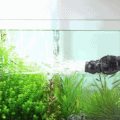




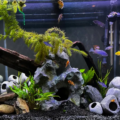

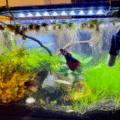
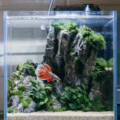
15 thoughts on “Easy Aquarium Plants For Beginners”